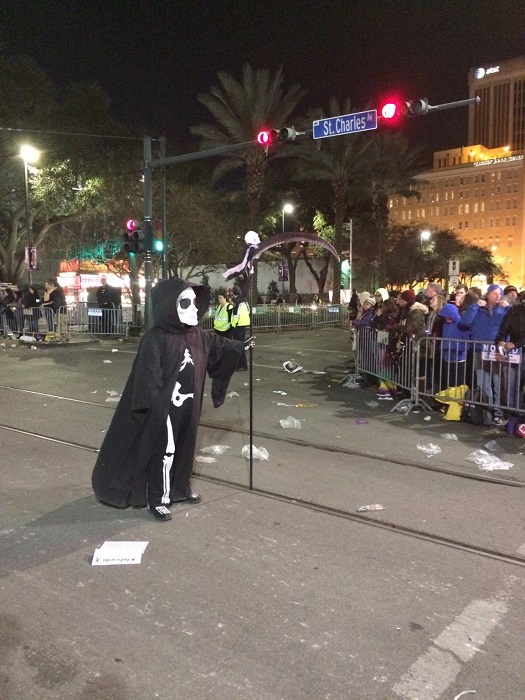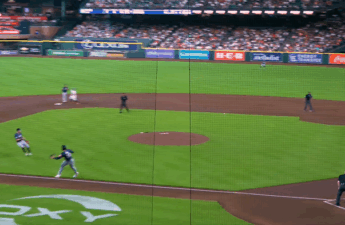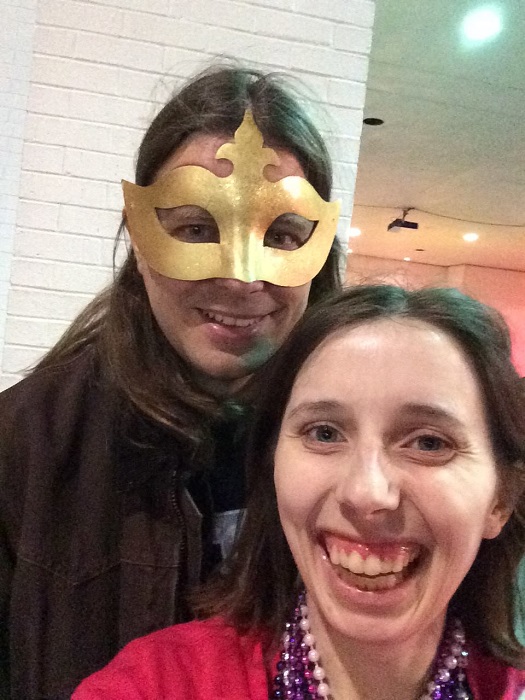
I’ve been trying to explain to people all week what I loved so much about Mardi Gras. For those who were here, or have been here, the explanation works a little better. I am here attempting to distill an explanation, obviously, that works better for a wider audience, that can convey to you – since you probably were not here and quite possibly have never been here – what made Mardi Gras so unexpectedly special. It’s a bit like trying to explain to Alex (who is here and was here) what I like so much about New Orleans. It defies the easy and effable assumptions.
It should be clarified that when I say “Mardi Gras”, I don’t mean that Tuesday that falls before Ash Wednesday, marking the last joyous day before forty long days of Lent. I mean the entire season that culminates in that day in the city of New Orleans and its surrounding environs. It was one of my many flawed assumptions, commonly held misconceptions even, that Mardi Gras is basically just one big glorious blowout day before Lent settles in. It’s really a mini-season running from Twelfth Night (that number of days after Christmas) to Mardi Gras day itself, an age littered with parades, beads, king cake, and revelry of all sorts. I have never seen, with the possible exception of my parents’ neighborhood on Christmas Eve for luminarias in Albuquerque, a city get so decked out and so fully embrace a holiday as New Orleans does for the Mardi Gras season. There are flags, lights, bunting, banners, signs, and the participation rate in this decor is extremely high. It put Christmas to shame, and Christmas was well-embraced for a city that functionally (my header graphic aside) never sees snow.
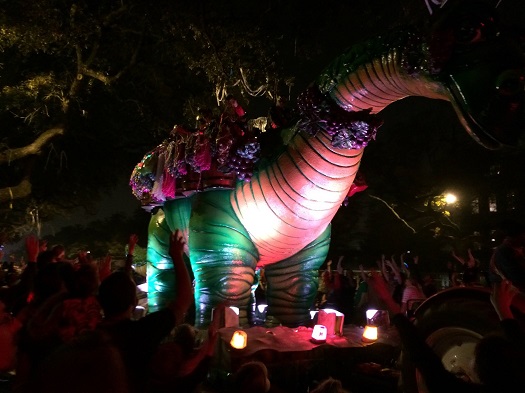
The next flawed assumption about Mardi Gras is that the receipt of beads is some sort of exchange for lascivious behavior. There are places where this transaction still takes place, or place really, namely Bourbon street, where affection-starved men will fling beads off their overpriced balcony to briefly bare-breasted women below. And it’s possible that the roots of all bead-throwing rituals are in this kind of overtly chauvinistic power-structure. But much as we can have gay marriage and equal marriages in today’s society despite the heritage of quasi-chattel slavery marriages, bead-throwing at Mardi Gras is quite equal-opportunity, with the scales slightly tilted in favor of children. Especially those who are trundled up to these ladder contraptions with makeshift wooden car-seat boxes atop, a wooden pole belting them in to assure that they don’t spill out and over as they reach ten young digits for the next strand of airborne color. Usually these are backed by increasingly exhausted parents, disproportionately mothers, who do most of the actual catching, as well as the bagging of various beads, stuffed animals, glowy ornaments, sports equipment, and plastic-but-metal-sounding coins that stream through the air.
There is a lot I could conceivably object to about this practice, to take care of the counter-arguments up front. There is certainly a materialistic core to the event that made me uncomfortable at times. It is possible to step back from the event and see a metaphor for the nation itself – thousands of adoring supplicants charging the gilded chariots of those with all the power/money/prestige, begging for worthless trinkets with perceived value. There are sometimes even echoes of the concentration camp guard flinging bread to prisoners when a particularly taunting float-rider will stingily toss one or two strands into a scrum. None of this is aided by the fact that it is common practice for those in a “krewe” (yes, note the replacement of a traditional C with a K already) to hide their identity, making many of the outfits and especially headgear a little too reminiscent of the Klan, especially when the chosen color is white. And it is hard to ignore the environmental impact of literally millions of strands of plastic beads being manufactured for the sole purpose of this ode to trinketry. Especially when the remains of any given parade literally litter the streets as crowds disperse, mixed with spilled alcohol, peanut shells, plastic cups, and broken glass. Hundreds of glittering strands of broken beads await the cleanup crew to sweep them into the trash so the next march can commence.
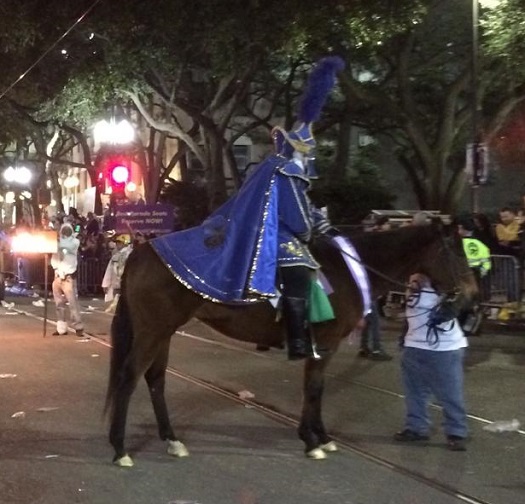
I’ve made quite a case for it, huh?
But the event of Mardi Gras itself, both within an individual parade and across the entire duration of the collective festivities, a real sense of innocence, wonder, and joy pervade. There is a lingering ostensible justification of the Lenten restraint to follow, but this inspiration has empirically diminished or possibly crumbled. In its wake, the sheer revelry for the sake of revelry reigns supreme, as best embodied by children who have no need to question or analyze a celebration. It’s also worth noting that many of these children are growing up in substandard socioeconomic circumstances and a vast quantity of the throws from various floats are toys or stuffed animals of one kind or another. I witnessed some kids receiving a modest Christmas’ worth of playthings at a single parade … and there are about forty parades. As much as we can cast a materialistic lens on this happening, there was also a fair sense of Robin Hood in the air, but a more Scroogeian Robin Hood or even better, the kind of taking from the rich that is, indeed, the rich’s own idea.
Secret societies afloat aside, there was also an incredible sense of community camaraderie on the sidelines of each of these parades. Granted that there was some drunken insanity closer to Canal Street, but posting up nearer our apartment around Napoleon & St. Charles or even down by Poydras and St. Charles in the downtown district, a family atmosphere dominated. Class distinctions of all kinds evaporated as tourists and locals mingled across all ages and sects to vie for the multitude flying off each float. There were a couple overly competitive people, mostly hailing from the Northeast, who grabbed and snatched and ripped things from one’s hands, but almost everyone was smiling, laughing, and quick to let go a strand that garnered mutual attachment. When the average person seemed to get about 25 strands of beads, plus assorted cups and goodies, from each individual parade (and there were often 2-3 in a row), there was more than enough to go around.
I also learned recently that the roots of much of the Mardi Gras regalia are Russian in nature, only increasing my visceral positive associations with the ongoing event. While the Catholic traditions brought by the French and Spanish started Mardi Gras celebrations in the 18th century in New Orleans, it wasn’t until the 1872 arrival of a Romanov Grand Duke that Mardi Gras had a “Rex” – the presiding king of Carnival, who also bestowed the Russian royal family’s crowning colors of purple, gold, and green on the event.
All of these seem like minor, technical reasons for falling in love with the holiday so robust that most everyone gets 3-5 days off work and the entire city shuts down. And, like snow days and a few other holidays or events, shutting a city down itself is a cause to enjoy a phenomenon, taking everyone outside their workaday perspectives and into the streets to bond and unite and see the world anew. There is something deeper than all this, something beyond the primal competitiveness that is stoked by vying for colorful beads and even beyond the simple joy of watching people dance with fire, dance in costume, dance along to the drum twice their size that they beat in tempo.
I think it has to do with magic.
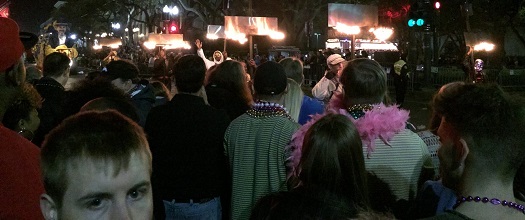
New Orleans is one of the few places in America that carries a deep, spiritual sense with it. It is perhaps the only major city to have this distinction. When I visited India, the entire country and even more of bordering Nepal seemed utterly drenched with symbolism, spirituality, deeper meaning, and even magic. I’m sure I’m losing some readers with this rhetoric, but I can only say that some places feel like there is something deeper going on and some don’t. If you’ve seen Eddie Izzard, his discussion of Stonehenge’s location speaks to this a bit – he illustrates how Stonehenge is built on an eerie windswept plain, whereas Manhattan could never host something like that. Well, here, from the transcript of “Dress to Kill”:
“But they built Stonehenge, and it’s built in an area called Salisbury Plain in the South of England. The area of Salisbury Plain where they built it is very ( eerie chanting ), ’cause that’s good, you know. It’s a mystical thing; build it in a mystical area. You don’t want to build it in an area that’s ( singing upbeat jazzy tune ). No, there you build Trump Tower.”
If you’re not an Izzard fan or you’re just not going to use a comedian as evidence for the variable nature of physical locations’ spiritual properties, perhaps you can imagine yourself in a graveyard or at the Wailing Wall. I’ve never been, but it seems obvious to me that most of the Arabian Peninsula and especially its western portions are similar to India, just embedded with a sense of Purpose and Depth. It’s hard to imagine people fighting so hard over the city of Jerusalem without this reinforcing sense of its importance beyond just reading the books that say so. And domestically, it’s pretty much just New Mexico and New Orleans that achieve that for me, that trips my radar in the same way. And some National Parks, I guess, notably the Grand Canyon and Yellowstone. My contention is that there just are some innately holy places in the world, charged with significance of a more ethereal nature. And New Orleans is one of them.
So when you take a holy place, dress it up in a unique combination of colors, stream color across every tree and branch and spare bit of fence, dress everyone up, and shut the city down, you get an alchemy that is greater than the whole of its analyzable parts. Yes, you get some craziness and drunkenness and people who take it too far or in an obnoxious direction. But you also get the unbridled wonder of children and tourists and first-timers reveling in the sheer scale and size of the alligators lumbering down the city streets, the poles aflame with live fire, the largess bestowed upon the joyous crowd.

There’s probably a bit of the costumery, mysticism, decoration, and kindness of strangers of Halloween thrown in there too. Indeed, much of my strong gut favoritism to Mardi Gras may just be that it’s all a repackaging of Halloween in slightly fancier dress. And in February. When it’s alternately 35 and 75 out, as it was at the beginning of different parades this month. A little testament to the instability of a haunted land that could be washed away in an instant, with a spirit that lives forever.
